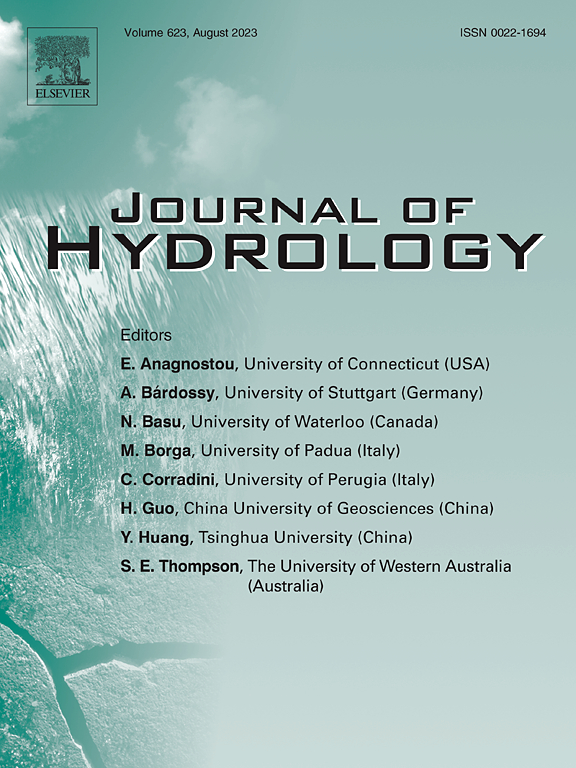测量大雨滴大小和速度的挑战:所选方法的比较
IF 5.9
1区 地球科学
Q1 ENGINEERING, CIVIL
引用次数: 0
摘要
雨滴的特性在气象学、水文学、农业、园艺、天气预报和大气物理等各个领域都起着至关重要的作用。在表征降水的各种技术和测量设备中,目前最常用的是分流表,高速摄像机也越来越受欢迎。一个重大的挑战可能是描述大水滴的特征,例如与穿透现象或强对流暴雨有关,它们容易因振荡而发生形状变化。因此,本研究的目的是评价所选择的测量大液滴大小和速度的方法的适用性。该研究基于特定直径(3.2、4.3和5.3 mm)和不同释放高度(1、3和5 m)的单滴形成。所进行的分析包括从两种类型的激光测量仪(Thies Clima LPM和Parsivel2),单个高速摄像机和一组同步高速摄像机获得的数据进行比较,这些高速摄像机带有3D PTV模块(即粒子跟踪测速)。使用高速成像技术对可能影响结果的水滴形状变形特征进行了评估,从而补充了测量结果。研究表明,高速摄像机可以非常准确地分析大型单个液滴的参数(即大小,速度和形状描述符),而测试的液滴测量仪则显示出结果的实质性变化。所测参数的变异系数对于照相机可达5.5 %,对于分流仪可达13.6 %。在这种情况下,高速摄像机为测量过程提供了一种替代方法,这些过程在基于测差仪的测量中容易产生重大误差(例如,与水滴形状的不规则性和可变性有关),例如通落,并且作为验证广泛使用的仪器的有价值的工具。更重要的是,结合PTV模块的相机组提供了一个完整的雨滴下落轨迹的3D地图,允许深入了解单个雨滴的速度分量(垂直分量,Vy,水平分量,Vx和Vz),这在雨滴飞行受到风干扰的情况下可能很重要。本文章由计算机程序翻译,如有差异,请以英文原文为准。
Challenges in measuring the size and velocity of large raindrops: a comparison of selected methods
The characteristics of raindrops play a crucial role in various fields, including meteorology, hydrology, agriculture, horticulture, weather forecasting, and atmospheric physics. Among the various techniques and measurement devices for characterising precipitation drops, disdrometers are currently most commonly used and high-speed cameras are becoming more popular. A significant challenge can be the characterisation of large drops, associated with e.g. throughfall phenomenon or heavy convective rainstorms, which are susceptible to shape changes as a result of oscillations. Thus, the aim of the study was to evaluate the suitability of selected methods for measuring the size and velocity of large drops. The study was based on the formation of single drops with specified diameters (3.2, 4.3 and 5.3 mm) and different heights of release (1, 3 and 5 m). The performed analyses included a comparison of data obtained from two types of laser disdrometers (Thies Clima LPM and Parsivel2 ), single high-speed camera and a set of synchronised high-speed cameras with 3D PTV module (i.e. particle tracking velocimetry). The measurements were complemented by a characterisation of drop shape deformation that may have influenced the results, which was assessed using high-speed imaging technique. Study showed that high-speed cameras allowed a very accurate analysis of the parameters of large individual drops (i.e. size, velocity and shape descriptors) in contrast to the tested disdrometers which showed substantial variability in the results. The coefficient of variation for the measured parameters was up to 5.5 % for the cameras, and up to 13.6 % for the disdrometers. In this context, high-speed cameras provide an alternative for measuring processes that are subject to significant errors (e.g. related to the irregularity and variability of the drop shape) in disdrometer-based measurements, such as throughfall, and serve as a valuable tool for validating widely used instruments. What is more, the use of camera set combined with a PTV module provides a full 3D mapping of the trajectory of falling drop, allowing insight into the velocity components (the vertical component, Vy, and horizontal components, Vx and Vz) of individual drops, which could be important in the case of drops whose flight has been disturbed by wind.
求助全文
通过发布文献求助,成功后即可免费获取论文全文。
去求助
来源期刊

Journal of Hydrology
地学-地球科学综合
CiteScore
11.00
自引率
12.50%
发文量
1309
审稿时长
7.5 months
期刊介绍:
The Journal of Hydrology publishes original research papers and comprehensive reviews in all the subfields of the hydrological sciences including water based management and policy issues that impact on economics and society. These comprise, but are not limited to the physical, chemical, biogeochemical, stochastic and systems aspects of surface and groundwater hydrology, hydrometeorology and hydrogeology. Relevant topics incorporating the insights and methodologies of disciplines such as climatology, water resource systems, hydraulics, agrohydrology, geomorphology, soil science, instrumentation and remote sensing, civil and environmental engineering are included. Social science perspectives on hydrological problems such as resource and ecological economics, environmental sociology, psychology and behavioural science, management and policy analysis are also invited. Multi-and interdisciplinary analyses of hydrological problems are within scope. The science published in the Journal of Hydrology is relevant to catchment scales rather than exclusively to a local scale or site.
 求助内容:
求助内容: 应助结果提醒方式:
应助结果提醒方式:


